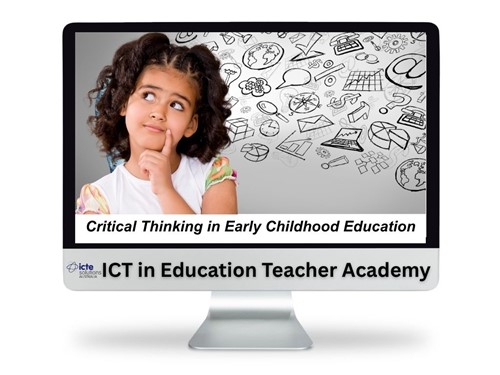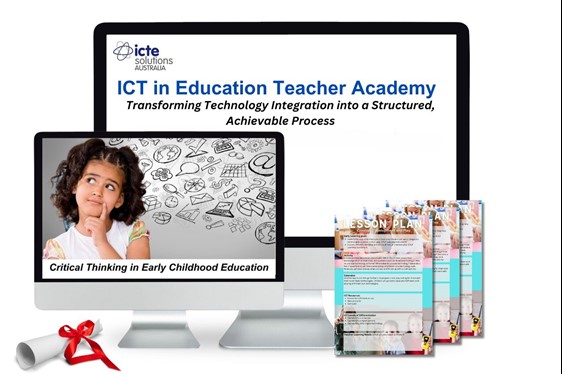By Michael Hilkemeijer

Using Technology with Purpose in Early Childhood
Why intentional digital tools can build stronger thinkers
In today’s early learning classrooms, our role as educators has evolved. It’s no longer just about helping children use technology—it’s about using technology to help children think. And one of the most powerful teaching questions we can ask is: how does technology improve critical thinking?
Whether we’re guiding a child through a coding challenge, supporting digital storytelling, or reflecting on a photo they’ve taken, these moments are shaping their ability to ask questions, test ideas, and make meaning from experience.
Let’s explore what this means in practice—and how you can begin using early years critical thinking activities powered by technology in your classroom.
What Does Critical Thinking Look Like in the Early Years?
In early childhood, critical thinking is often visible in small but powerful moments:
-
A child considers which photo to include in their nature journal—and why.
-
Two children debate which direction the Bee Bot should turn.
-
A child revises a drawing on-screen after noticing something new outdoors.
These are all forms of inquiry, reflection, and problem-solving—and digital tools can make these thinking processes visible and engaging.
So, How Does Technology Improve Critical Thinking?
Digital tools provide:
-
Opportunities to explore multiple solutions (e.g., coding paths, storytelling formats)
-
Space to reflect and revise (e.g., re-recording audio, redrawing a picture)
-
Encouragement for prediction and testing (e.g., “What will happen if I press this?”)
-
Platforms for collaboration (e.g., building a shared story or puzzle)
The key is not just using devices—but using them in purposeful, play-based experiences designed to build thinking. And that’s exactly what members of the ICT in Education Teacher Academy receive: lesson plans that embed digital tools into early years critical thinking activities—not just screen time.
Technology-Enhanced Activities That Build Critical Thinking
Here are 10 critical thinking activities for preschoolers examples drawn directly from the ICT in Education Teacher Academy. Each one is a member-exclusive resource with built-in assessment tools, EYLF alignment, and extension ideas.
1. Outdoor Digital Storytelling
Children explore their outdoor environment with tablets, recording nature sounds. They combine these with images and narration to tell a story using Book Creator.
🧠 Thinking developed: Analysis, creativity, collaboration, evaluation
💡 Early years critical thinking activity: Choosing meaningful sounds, deciding how to structure a story, evaluating which parts to edit or keep.
🔗 Based on the member lesson: Outdoor Digital StorytellingOutdoor digital storyte…
2. Coding with Nature and Programmable Toys
Children guide Bee Bots through obstacle courses made of leaves, rocks, and sticks. They predict, program, test, and debug as they try to reach specific targets.
🧠 Thinking developed: Logical reasoning, sequencing, trial and error
💡 Early years critical thinking activity: Planning a route, adjusting when it fails, collaborating to find solutions.
🔗 Based on the member lesson: Coding with Nature
3. Taking Apart a Computer
Using an old (safe) computer tower, children explore its parts, make predictions about their functions, and reflect on how technology works in their daily lives.
🧠 Thinking developed: Classification, questioning, problem-solving
💡 Early years critical thinking activity: Asking “what is this?”, explaining what they think it does, comparing parts to other tools they know.
🔗 Based on the member lesson: Taking Apart a Computer
4. QR Code Nature Hunt
Children scan QR codes hidden outdoors to discover facts about plants, insects, or the weather.
🧠 Thinking developed: Interpretation, analysis, digital navigation
💡 Early years critical thinking activity: Deciding how the new information connects to what they already know and sharing discoveries through digital storytelling.
🔗 Based on the member lesson: QR Code Nature HuntQR code nature hunt
5. Abstract Art with Bee Bot
Children program Bee Bots with coloured markers attached to create abstract artwork. They reflect on the patterns and lines produced.
🧠 Thinking developed: Creativity, logic, design interpretation
💡 Early years critical thinking activity: Explaining the result of a programmed movement, evaluating what to try next, and making aesthetic decisions.
🔗 Based on the member lesson: Abstract Art with Bee Bot
6. Digital Nature Walk & Photography
Children use digital cameras or tablets to capture textures, patterns, and shapes in nature. These are used to create digital collages.
🧠 Thinking developed: Observation, comparison, synthesis
💡 Early years critical thinking activity: Identifying patterns, discussing similarities/differences, and organising images for meaning.
🔗 Based on the member lesson: Digital Nature Walk and Photography
7. Drawing with Programmable Toys
Markers are attached to Bee Bots or similar tools. Children plan paths and see how their instructions turn into drawings.
🧠 Thinking developed: Planning, reasoning, spatial awareness
💡 Early years critical thinking activity: Making predictions, adjusting sequences, and evaluating results.
🔗 Based on the member lesson: Drawing with Programmable Toys
8. Sorting Animals with Digital Tools
Children use a word processor and digital images to sort animals into categories (e.g., pets, wild animals).
🧠 Thinking developed: Classification, digital literacy, reasoning
💡 Early years critical thinking activity: Choosing how to group, justifying decisions, and using software to express understanding.
🔗 Based on the member lesson: Sorting Animals
9. Bee Bot School Bus
Children create a “street” for a Bee Bot acting as a school bus, collecting passengers (toys) from different locations.
🧠 Thinking developed: Sequencing, decision-making, navigation
💡 Early years critical thinking activity: Deciding routes, adjusting for obstacles, and reflecting on how to improve the journey.
🔗 Based on the member lesson: Bee Bot School Bus
10. Augmented Reality Nature Exploration
Using apps like Seek by iNaturalist, children scan plants and insects in real time, then record findings in a digital journal.
🧠 Thinking developed: Inquiry, evaluation, digital documentation
💡 Early years critical thinking activity: Comparing species, identifying patterns, and deciding what to document and why.
🔗 Based on the member lesson: Augmented Reality Outdoor Activity
These early years critical thinking activities don’t just make use of technology—they make thinking visible. And with every activity inside the ICT in Education Teacher Academy, you’ll find:
-
Clear learning goals
-
Differentiation strategies
-
Critical reflection prompts
-
Planning support
-
And alignment with EYLF and APST
All of this supports your growth—not just the children’s.
Why Educators Need More Than Activities—They Need Support
Most online activities focus on fun. But the membership gives you a structured path to progress:
-
A professional learning workbook that helps you track how activities grow children’s thinking.
-
A Success Path that moves you from Adoption to Transformation as an educator using ICT.
-
Access to the Wisdom Tool and community forums, where you can share adaptations, ask questions, and learn from peers.
-
Planning templates that connect your critical thinking activities to EYLF outcomes, ICT capability, and formative assessment.
You’re not downloading random ideas. You’re following a professional growth journey—with support every step of the way.
Final Thoughts: Small Activities, Big Impact
The next time you wonder how does technology improve critical thinking, start with a simple, purposeful activity—one that invites children to wonder, question, and reflect.
And if you're looking for early years critical thinking activities that are ready to use and professionally aligned, the ICT in Education Teacher Academy was built for you.
👉 Download your first digital thinking activity today and begin your transformation.

What is Critical Thinking in ECE?
In the Early Years Learning Framework (EYLF) play enables young children to ask questions, solve problems and engage in critical thinking in early childhood education. It promotes a positive disposition towards learning.
It occurs when children draw on their existing knowledge and experience. Problem-solving also facilitates critical thinking when they:
- Compare and contrast;
- Explain why things happen;
- Evaluate ideas and form opinions;
- Understand perspectives of others;
- Predict what will happen in the future;
- Think creative solutions.
Critical thinking is first developed at a very young age and these skills develop during the natural conversations that children have with the important adults in their lives.
Young children need to be able to develop skills to critically analyse and respond to a wide range of evidence about the world around them and learn about the values and the experience of being human.
Supporting the development of critical thinking
There are a number of ways in which you can support the development of critical thinking.
- Encourage pursuits of curiosity – help them explore, ask questions, test their theories, and think critically about results and to think about changes they could make or things that they could do differently.
- Learn from others – help them to think more deeply about things by instilling a love of learning and a desire to understand how things work.
- Help children evaluate information – with all the information that is out there it is important that you help children learn the skills they need so that they can evaluate information. They will need to think about where or who the information is coming from, how it relates to what they already know and why it is or is not important.
- Promote children’s interests – children become more motivated and engaged in their learning activities if it is something that they are interested in. Help them to expand their knowledge as this will promote critical thinking.
- Teach problem-solving skills – critical thinking is necessary for solving problems or conflicts where they can come up with solutions.
Digital play and Critical thinking
Teaching digital literacy in early childhood education ensures that you will also be teaching critical thinking in a digital world.
For example, it is through making digital images that young children learn that pictures are made just as text is made and this is an early childhood learning experience that will help them to become critical consumers of visual bombardment. Just as the earlier generation become critical readers of print.
However, a better answer as to why is critical thinking important in early childhood education is that it is fundamental for both literacy and language development.
Language skills will expand as a consequence of young children engaging in critical thinking and for them to understand a book, critical thinking skills such as problem-solving, predicting and explaining are required.
Here are some examples of critical reflection in early childhood education when integrating digital technology:
Digital technology in preschool classrooms such as word processors is a valuable tool that allows writers to merge and revise ideas that is integral to creative and critical composing.
Digital play in the early years learning environment that supports inquiry-based learning can also support critical thinking in early childhood education as it offers opportunities for linking learner engagement to curriculum content.
Technology can support outdoor learning which in turn promotes interactivity, motivation, levels of physical activity and being outdoors. For example, young children could be playing with a metal detector, where they are developing their critical thinking by testing their ideas; operating the tool with precision and spatial awareness.
Another example of critical reflection in early childhood education is when young children learn to reflect on their animation product. They could determine aspects of the work which needed changes and identify features that were successful in meeting the audience’s needs and repeating these.
It is often through such productions of kinds of texts that children begin to understand texts in a critical way. This focus on the manipulation of visual images may enhance children’s abilities to read the images in a more critical manner.
The digital society where we all mostly reside in has ensured that critical thinking along with information retrieval, decision-making and communication is high on the agenda. Critical thinking in early childhood education is the catalyst for young children to be critical consumers of information and digital technology – critical skills for a future workforce.


Ready to Teach Thinking with Purpose?
When technology is used intentionally in early childhood, it becomes a powerful tool for building curiosity, reflection, and problem-solving. The activities you've explored here show just how possible—and practical—it is to nurture critical thinking from the earliest years.
Inside the ICT in Education Teacher Academy, you'll get access to all these EYLF-aligned lesson plans and more—plus professional learning tools that guide your planning, support assessment, and help you grow as a confident technology integrator.
Become a member today and save $40 instantly when you choose the annual plan—just $200 for a full year of done-for-you resources, training, and support.
What could you do in your classroom tomorrow if you had the right tools and guidance today?
